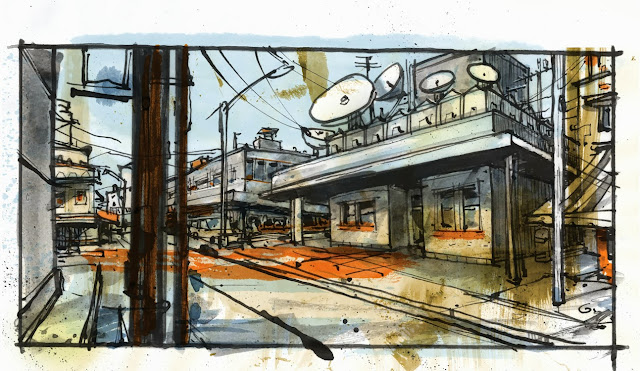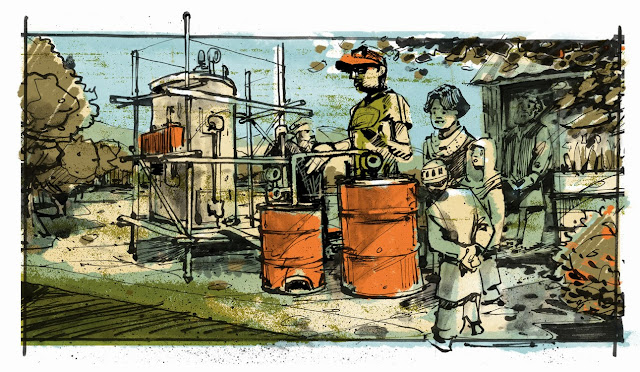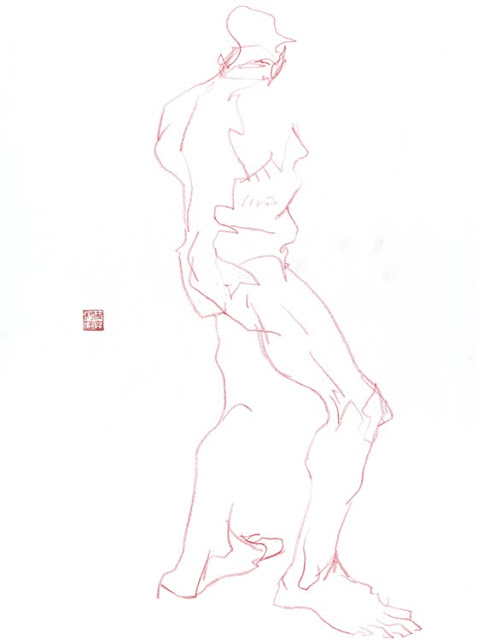Beer for Data - Illustration Process from
Graham Smith on
Vimeo.
"It was a dark time in a long, drawn-out war. Afghanistan was festering with resentment. The Pentagon brass were desperate. It was the kind of last-ditch moment when authorities start throwing an era’s weirdest ideas at its most hopeless bureaucratic mistakes."
Pacific Standard hired me to illustrate an article about the war in Afghanistan, and a bunch of "Burners" lead by Dr. David Warner, the called the
Synergy Strike Force. They succeeded in trying to "hack the war", only miles from the treacherous Tora Bora Mountains, from the only bar in Jalalabad, Afghanistan.
This story begins in Wartime Afghanistan, with a few smart guys building schools and installing solar generators. It ends with the burning of Koran's at Bagram Airforce base by US soldiers, and the riots that erupted afterwards.
Once stateside, the story is returns to another burning, a bittersweet ceremony where the Burning Man's Temple was razed, deep in Nevada's Black Rock desert. Goodbyes were said to those lost in the war.
Illustrating a reality based series about the war is a great responsibility, and a super fun project!
But where to start? How do you know what to draw? What is the illustration process?
Research: Illustrations are based on written descriptions from the article, and reference photos culled from the interwebs. It is helpful to research the objects in a reality based illustration. I read the manuscript and highlight the descriptive passages, then list all the objects to be illustrated, and Google them.
Ideas: Draw thumbnails: The goal is to put your thoughts on paper, and to generate ideas by letting facts, graphic themes, and subconscious ideas link from one little drawing to the next - evolving as they go. This is a really fun part of the process, where any idea, no matter what, gets drawn in a little box.
Edit: The best thumbnails are enlarged, and refined into bigger pencil sketches. They are reviewed by the art and editorial staff, and placed into temporary layouts to get a sense of how the illustrations will live inside the design.
Refine: Sketches are usually developed with anything handy, and fast. In this case, graphite. The rough pencil sketches are used as a guide for the more carefully done ink drawing.
Draw: On approval, the chosen sketch is redrawn with ink on a separate piece of translucent vellum or paper. A quill pen, and india ink are used to draw each illustration.
Finish: Color, and mono-printed textures are are added digitally in Photoshop, as is the final resizing, and preparation for printing. The final print ready, Photoshop files are delivered via internet.
While I'm drawing, I'm also filming.
An iPhone camera captures time-lapse footage while attached to a overhead desk lamp. Between each drawing, I reposition my low end DSLR, (Canon T4i /650D) to film a different angle, setting the exposure, and depth of field, before resuming to draw. The footage is knocked together in iMovie.




















































